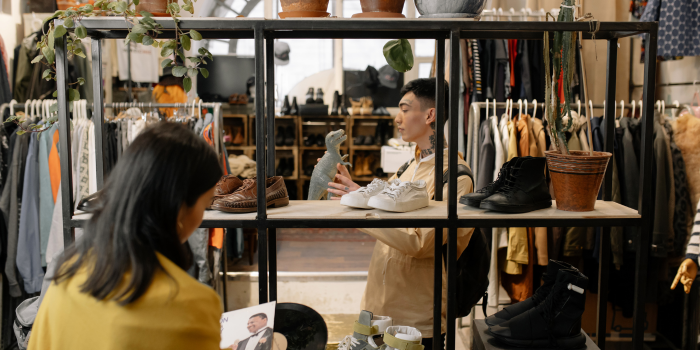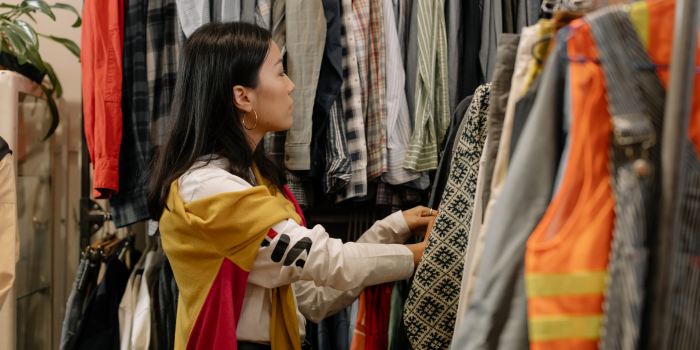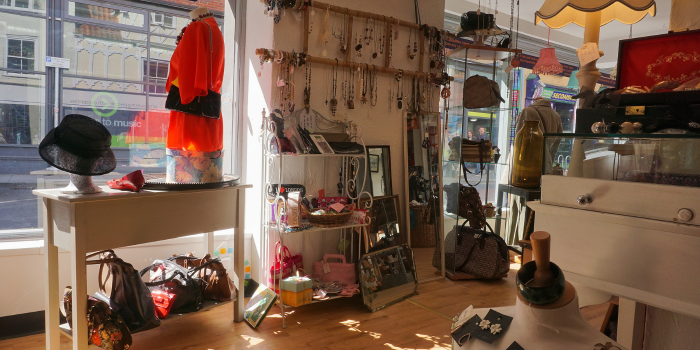Shopping secondhand is a practice that involves buying or selling used goods, such as clothes, furniture, books, or electronics. Shopping secondhand can be done through various channels, such as thrift stores, online platforms, flea markets, or swap parties. Shopping secondhand can have many benefits for you, your community, and the environment. In this article, we will explore some of the reasons why you should shop secondhand, and provide some tips on how to shop secondhand effectively.
How does shopping secondhand benefit the environment?
Shopping secondhand benefits the environment by reducing waste, emissions, pollution, and resource consumption. Here are some of the main ways that shopping secondhand helps the environment:
- Reduce waste: Shopping secondhand reduces waste by preventing the disposal of useful items that would otherwise end up in landfills, incinerators, or oceans. For example, according to Zero Waste Europe, every ton of textiles reused can save 20 tons of CO2 equivalent1. Shopping secondhand also extends the life cycle of products, which means less demand for new products and less waste generation.
- Reduce emissions: Shopping secondhand reduces emissions by preventing the production of new products that require energy and materials that contribute to global warming. For example, according to Choose to Reuse, every ton of paper reused can save 17 trees2. Shopping secondhand also promotes the use of renewable energy sources, such as solar or wind power, which have lower carbon footprints than fossil fuels.
- Reduce pollution: Shopping secondhand reduces pollution by preventing the release of toxic substances into the air, water, and soil that result from the manufacturing or disposal of new products. For example, according to Zero Waste International Alliance, every ton of waste reused can save 10 tons of water pollution3. Shopping secondhand also promotes the use of natural or organic products, such as biodegradable or compostable packaging, which have lower environmental impacts than synthetic or plastic products.
- Reduce resource consumption: Shopping secondhand reduces resource consumption by preventing the overuse of finite or scarce resources, such as metals, minerals, or fossil fuels. For example, according to Zero Waste World, every ton of waste reused can save 20 tons of raw materials4. Shopping secondhand also promotes the use of local or recycled resources, such as second-hand or upcycled products, which have lower environmental impacts than imported or virgin resources.
How does shopping secondhand benefit your community?

Shopping secondhand benefits your community by creating jobs, saving money, improving health, and fostering social cohesion. Here are some of the main ways that shopping secondhand helps your community:
- Create jobs: Shopping secondhand creates jobs by generating more opportunities for employment in the sectors of waste prevention, reuse, recycling, repair, and composting. For example, according to Zero Waste Europe, every 10,000 tons of waste reused can create 210 jobs. Shopping secondhand also supports local businesses, such as thrift stores or repair shops, which provide income and services for the community.
- Save money: Shopping secondhand saves money by reducing the costs of buying new products, which are usually more expensive and less durable. For example, according to Choose to Reuse, every ton of waste reused can save $200 in product costs. Shopping secondhand also reduces the costs of environmental damage, such as climate change, pollution, or health impacts, which can affect the economy and society.
- Improve health: Shopping secondhand improves health by reducing the exposure to harmful substances or diseases that can result from buying new products or disposing of waste. For example, according to World Health Organization, every ton of waste reused can prevent 0.8 cases of diarrhea and 0.3 cases of respiratory infections. Shopping secondhand also improves the quality of life, such as by providing cleaner air, water, and soil, which can enhance physical and mental well-being.
- Foster social cohesion: Shopping secondhand fosters social cohesion by encouraging the participation and collaboration of different stakeholders in the community, such as individuals, households, businesses, organizations, or governments. For example, according to Zero Waste World, every ton of waste reused can involve 100 people in reuse activities. Shopping secondhand also promotes the values of solidarity, responsibility, and justice, such as by sharing resources, reducing inequalities, and empowering marginalized groups.
How does shopping secondhand benefit yourself?
Shopping secondhand benefits yourself by enhancing your skills, saving your time, improving your happiness, and expressing your personality. Here are some of the main ways that shopping secondhand helps yourself:
- Enhance your skills: Shopping secondhand enhances your skills by challenging you to learn new things and to improve your existing abilities. For example, you can learn how to find quality products, such as by checking the condition, functionality, and authenticity; how to negotiate prices, such as by haggling, bargaining, or trading; or how to repair or upcycle products, such as by sewing, painting, or gluing. You can also improve your skills in planning, organizing, budgeting, or researching.
- Save your time: Shopping secondhand saves your time by simplifying your life and reducing your clutter. For example, you can save time by buying less, which means less shopping, less cleaning, less sorting, and less disposing; by reusing more, which means less replacing, less repairing, and less maintaining; or by recycling more, which means less wasting, less storing, and less transporting. You can also use your time more wisely, such as by focusing on what matters most to you, such as your family, friends, hobbies, or passions.
- Improve your happiness: Shopping secondhand improves your happiness by increasing your satisfaction and gratitude. For example, you can increase your satisfaction by using quality products, which are more durable, functional, and beautiful; by enjoying experiences, which are more memorable, meaningful, and fulfilling; or by giving back, which are more generous, altruistic, and compassionate. You can also increase your gratitude by appreciating what you have, such as your health, wealth, and relationships; by acknowledging what you contribute, such as your talents, efforts, and achievements; or by celebrating what you receive, such as your gifts, opportunities, and blessings.
- Express your personality: Shopping secondhand expresses your personality by reflecting your values and preferences. For example, you can reflect your values by choosing products that are ethical, such as fair trade or cruelty-free; by supporting causes that are important to you, such as animal rights or social justice; or by joining movements that are inspiring to you, such as zero waste or veganism. You can also reflect your preferences by choosing products that are unique, such as handmade or customized; by creating styles that are original, such as vintage or eclectic; or by developing habits that are fun, such as swapping or upcycling.
How can you shop secondhand effectively?

Shopping secondhand can be easy, fun, and rewarding. You don’t have to compromise on quality or style to enjoy the benefits of shopping secondhand. You can shop secondhand effectively by following some tips and tricks that can help you find the best deals and products. Here are some tips on how to shop secondhand effectively:
- Do your research: Before you shop secondhand, do some research on what you need, want, or like. You can browse online platforms, such as eBay or Poshmark; check online reviews or recommendations, such as from blogs or magazines; or ask for advice or referrals, such as from friends or family. You can also compare prices, features, and availability of different products or sellers.
- Choose your sources: When you shop secondhand, choose your sources carefully and wisely. You can visit different types of places, such as thrift stores, online platforms, flea markets, or swap parties. You can also look for different types of products, such as clothes, furniture, books, or electronics. You can also consider different factors, such as location, reputation, quality, or variety of the sources.
- Inspect your products: When you shop secondhand, inspect your products thoroughly and cautiously. You can check the condition, functionality, and authenticity of the products. You can also test, try, or measure the products if possible. You can also ask questions, request information, or negotiate prices if necessary.
- Enjoy your products: When you shop secondhand, enjoy your products fully and responsibly. You can clean, repair, or upcycle your products if needed. You can also use, wear, or display your products with pride and joy. You can also share, donate, or resell your products if you don’t want them anymore.
Conclusion
Shopping secondhand is a practice that can have many benefits for you, your community, and the environment. Shopping secondhand can help you reduce waste, emissions, pollution, and resource consumption; create jobs, save money, improve health, and foster social cohesion; enhance your skills, save your time, improve your happiness, and express your personality. Shopping secondhand can also be easy, fun, and rewarding. You can shop secondhand effectively by doing your research, choosing your sources, inspecting your products, and enjoying your products. We hope you enjoyed this article and found some inspiration for your next secondhand shopping adventure. And don’t forget to subscribe to our newsletter for more tips, tricks, and resources on living a more eco-friendly and frugal life. Until next time, stay green and stay happy! 😊

Iryna wants to make this world a better, greener place with less waste. Her mission is to protect the planet from plastic pollution by bringing awareness to this global crisis through her website. Send her an email to learn more about her mission and how we can help!



